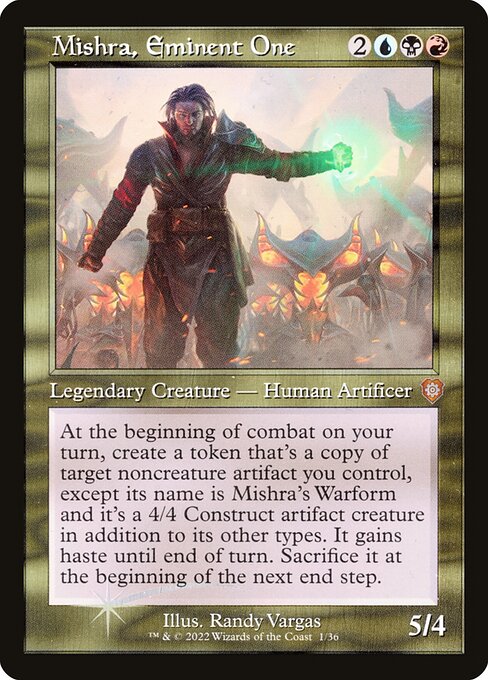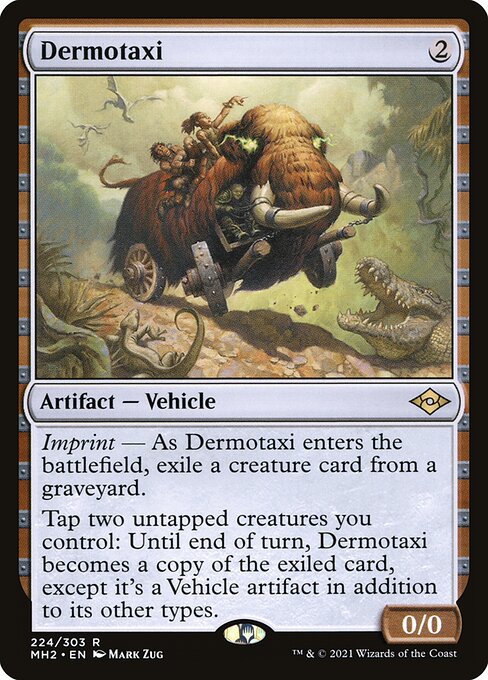Cover image: Mishra, Eminent One by Randy Vargas
It seems like just a couple of weeks ago that we were speculating on the playability of The Raven Man and planning for a Pioneer with Liliana and painlands—probably because that actually was a few scant weeks ago. But I won’t bemoan the early previews for The Brothers’ War, particularly when they include the return of Meld and the announcement of all retro-border Commander decks. Both brothers are getting a Commander deck built around them; Urza, Chief Artificer is fine but predictable, an Affinity general with the now-standard Construct payoff, but Mishra, Eminent One is especially intriguing.
This isn’t the first Mishra we’ve seen, but Time Spiral’s Mishra, Artificer Prodigy was designed for a different era. Commander was Elder Dragon Highlander back then, and most players who had heard of it were still playing the Elder Dragons. The casual format of choice was four-of self-regulating “kitchen table Magic.” That mode of Magic has fallen by the wayside, but, for a time, it was the primary way that non-tournament players engaged with the game. I recognize that “Rule Zero” discussions are tedious at the start of a Commander match, but imagine having them about how one player brought a Recurring Nightmare/Survival of the Fittest combo deck and someone else brought an unmodified Shadowmoor theme deck.
I’ve seen a Mishra Commander deck or two, mostly exploiting Possibility Storm to get a free artifact or Blood Funnel or Nether Void as ways for Mishra to pull the artifact from the graveyard after it’s countered, but it’s always been more of a deckbuilding challenge than a competitive strategy. I had some fun with him back in 2006, doubling up my Mishra’s Baubles in one of the game’s stranger Standard environments, but he’s more Blind Seer than Urza, Lord High Artificer.

In contrast, Brothers’ War Mishra is designed for the modern era of Commander, which means he’s beefier and all upside. For five mana, we get a 5/4 who makes temporary, hasty 4/4’s, which is quite an upgrade for one mana over the original Mishra. Where the Artificer Prodigy had you jumping through hoops and loops for a benefit, this latest incarnation gives you a Yotia Declares War-inspired ability each combat.
As soon as he was revealed, people bought out Gonti’s Aether Heart, which goes infinite with Mishra and another artifact token producer, including Karn, Living Legacy. It’s impossible to resist that combo, and the imminent Warhammer Commander decks are loaded with options for the Eminent One. Because Mishra renames the tokens he makes as “Mishra’s Warform,” you can copy a Legendary permanent without having to lose either—for example, you can copy Weatherlight Compleated and have a 4/4 Mishra’s Warform with the Weatherlight’s textbox attacking that turn.
With a month-plus to go until Mishra drops, we’re planning for the future, but I’m excited about the direction the deck is taking:
Commander: Mishra, Eminent One
Creatures: Acolyte Hybrid, Anrakyr the Traveller, Arcbound Ravager, Arcbound Reclaimer, Audacious Reshapers, Breya’s Apprentice, Brudiclad, Telchor Engineer, Chromescale Drake, Chronomancer, Contraband Kingpin, Cyberdrive Awakener, Emry, Lurker of the Loch, Goblin Engineer, Imotekh, the Stormlord, Jin-Gitaxias, Progress Tyrant, Junk Diver, Kappa Cannoneer, Mahadi, Emporium Master, Marionette Master, Silas Renn, Seeker Adept, Skorpekh Lord, Thought Monitor
Planeswalkers: Daretti, Ingenious Iconoclast, Daretti, Scrap Savant, Karn, Living Legacy, Tezzeret, Betrayer of Flesh
Artifacts: Aethersphere Harvester, Blasting Station, Chromatic Lantern, Commander’s Sphere, Cursed Mirror, Dermotaxi, Dimir Signet, Embercleave, Golden Egg, Gonti’s Aether Heart, Ichor Wellspring, Imposter Mech, Izzet Signet, Kaldra Compleat, Knight Paladin, Krark-Clan Ironworks, Mirage Mirror, Mishra’s Bauble, Mox Opal, Mukotai Soulripper, Mycosynth Wellspring, Mystic Forge, Nautiloid Ship, Nettlecyst, Nihil Spellbomb, Oni-Cult Anvil, Prized Statue, Rakdos Signet, Sculpting Steel, Skysovereign, Counsel Flagship, Sol Ring, Weatherlight Compleated
Enchantments: Clan Crafter, Phyrexian Scriptures, Storm the Vault
Sorceries: Legerdemain, Rise and Shine, Their Name is Death
Lands: 5 Island, 5 Mountain, 4 Swamp, Academy Ruins, Blood Crypt, Command Tower, Drossforge Bridge, Glimmervoid, Inventors’ Fair, Luxury Suite, Mishra’s Factory, Mishra’s Foundry, Mistvault Bridge, Morphic Pools, Mutavault, Power Depot, Shivan Reef, Silverbluff Bridge, Steam Vents, Sulfurous Springs, Training Center, Underground River, Watery Grave, Xander’s Lounge
There are a lot of ways to take a Mishra deck: Gonti’s Aether Heart semi-infinite combo, Stax with Lodestone Golem and lock pieces, Altar of the Brood combos with various Voltaic Key loops, etc. I wanted something more interactive and modular (literally) that plays differently with Mishra out—there are some of the usual suspects here, but also oddball picks like Legerdemain and Dermotaxi, cards whose power scales to the cards you’re facing.

Mishra is all about power, but he’s also self-sabotaging and chaotic, and therefore an ideal Grixis character—he’s shortsighted, knowledgeable, and impetuous. Red/Blue is the traditional artificer archetype pairing, but the admixture of Black lets us exploit Marionette Master, Treasure synergy, and some of the prime Necrons. For flavor reasons, I couldn’t justify running Urza, Lord High Artificer, although he would be great in the deck; if you don’t feel that twinge, toss him in. The same goes for Urza’s Saga—aside from being expensive, it feels wrong to include it in a Mishra deck.
Like a lot of artifact Commander decks, this deck can be easily souped up with an unlimited budget: Metalworker would be an asset and Grim Monolith, aside from being flavorful, is an excellent Warform target. Then newly-revealed Transformer tie-in Flamewar is a bridge too far for me, personally, but if you’re a bit less picky about your aesthetics, it’s a great fit. Hellkite Tyrant and Mirrodin Besieged are good considerations for a playgroup that needs a quick win condition, but like Mishra before me, I don’t need to win: I just need to cycle through stacks of artifacts and threaten my opponents with massive war machines and sinister artificial abominations.

Note also that you sacrifice, rather than exile the Warform token, so you can reap any benefits from dying synergy even if you don’t toss it into the Krark-Clan Ironworks. Prized Statue, Mycosynth Wellspring, Gilded Egg, Ichor Wellspring—these are excellent utility cards that help you set up Mishra and then smack for four once he shows up. It’s small ball, but even something as straightforward as copying Mishra’s Bauble or Commander’s Sphere gives you a free Phyrexian Arena. As Lurrus taught us, sometimes that’s enough.
I love the contrast between Mishra and Urza: Urza’s artifacts and artificial soldiers are designed to be durable, while Mishra’s are ephemeral. Urza’s war engines and golems are still stalking present-day Dominaria, thousands of years later, while Mishra’s warforms are jury-rigged piles of scrap. The Phyrexian tech Mishra exploited is designed to be sacrificial, shock troops that carry plagues and become Blight Piles and Argivian artifacts after they slaughter opposing troops. It implies their different philosophies of artifice, with both brothers stripping Dominaria of its resources, but Urza building for the future and Mishra and his Phyrexian allies intent on winning at any cost with what’s at hand.
You can see this in the art for Mishra, Eminent One. While Urza’s artificial soldiers tend to be chunky, solid golems, Mishra’s staples glow with the heat of the forge, as though, like their master, they’re being consumed from the inside out. This is the Mishra who created Mishra’s Helix, the shortsighted and rapacious foil to Urza’s millennium-long machinations and stolid outlook. Mishra is charismatic, both seductive and easily seduced, and it feels great to be able to finally have a Commander deck that fuses his outlook and philosophy with the long legacy of absurd artifacts in Magic history.
Mishra feels equally at home exploiting Arcbound Ravager, Wurmcoil Engine, and Cyberdrive Awakener—anything it takes to win is something he’ll embrace. This is becoming a theme within the Grixis Artifact archetype, to my great pleasure: the color combo now has an established legacy of churning through Treasure tokens, cycling cards into and out of the scrapyard with various Goblins, and Tinkering out explosive targets. It’s potent, but easy to disrupt, and feels organically responsive to the rest of the table.
It remains to be seen what other tools The Brothers’ War will bring to Mishra, but even with just recently-printed cards, he’s a powerhouse—at least, until he overreaches and is consigned to the hellscape of Phyrexia.
A lifelong resident of the Carolinas and a graduate of the University of North Carolina, Rob has played Magic since he picked a Darkling Stalker up off the soccer field at summer camp. He works for nonprofits as an educational strategies developer and, in his off-hours, enjoys writing fiction, playing games, and exploring new beers.

